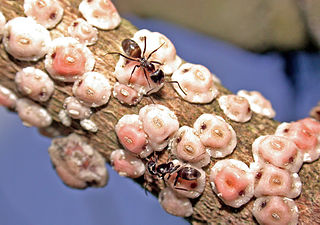
Dolichoderinae is a subfamily of ants, which includes species such as the Argentine ant, the erratic ant, the odorous house ant, and the cone ant. The subfamily presents a great diversity of species throughout the world, distributed in different biogeographic realms, from the Palearctic, Nearctic, Afrotropical region and Malaysia, to the Middle East, Australian, and Neotropical regions.

Amyrmex golbachi is a rare Neotropical species of ant and the only known species in the genus Amyrmex. It is currently only known from males from the Amazon basin of Brazil and from northern Argentina.

Dorymyrmex is a genus of ants in the subfamily Dolichoderinae.

Leptomyrmex, or spider ants, is a genus of ants and a distinctive member of the ant subfamily Dolichoderinae. Commonly known as "spider ants" for their long legs and spider-like movements, these orange and black ants are prominent residents of intact wet forest and sclerophyll habitats throughout their range. One extant species, Leptomyrmex relictus, is known from central Brazil; otherwise, the global distribution of this genus is restricted to eastern Australia, New Caledonia and New Guinea, as well as the nearby Indonesian islands of Aru and Seram.

Forelius is a Neotropical genus of ants in the subfamily Dolichoderinae. The genus is known from southern United States to Argentina.
Dorymyrmex amazonicus is a Neotropical species of ant in the subfamily Dolichoderinae.

Gracilidris humiloides is an extinct species of ant in the genus Gracilidris. It was discovered in the Dominican amber, only known from a single specimen, described by Wilson in 1985.

Gracilidris pombero is a species of ant in the genus Gracilidris. Described by Wild and Cuezzo in 2006, the species is endemic to the South American countries of Argentina, Brazil and Paraguay.
Dolichoderus debilis is a species of ant in the genus Dolichoderus. Described by Emery in 1890, the species is found in many countries in two continents, including Bolivia, Brazil, Colombia, Costa Rica, French Guiana, Guatemala, Guyana, Panama, Suriname, Trinidad and Tobago and Venezuela.
Dolichoderus diversus is a species of ant in the genus Dolichoderus. Described by Emery in 1894, the species has a widespread distribution in multiple countries, including Brazil, Colombia, Costa Rica, Ecuador, Guyana, Mexico, Panama, Trinidad and Tobago and Venezuela.
Forelius bahianus is a species of ant in the genus Forelius. Described by Cuezzo in 2000, the species is endemic to Brazil.
Forelius grandis is a species of ant in the genus Forelius. Described by Auguste-Henri Forel in 1912, the species is endemic to Argentina.
Forelius lilloi is a species of ant in the genus Forelius. Described by Cuezzo in 2000, the species is endemic to Argentina.
Forelius maranhaoensis is a species of ant in the genus Forelius. Described by Cuezzo in 2000, the species is endemic to Brazil.

Forelius mccooki is a species of ant in the genus Forelius. Described by McCook in 1880, the species is endemic to the United States and Mexico, where they nest in soil surrounded by a typically small mound, and also nests under stones.

Forelius nigriventris is a species of ant in the genus Forelius. Described by Forel in 1912, the species is endemic to South America.

Forelius pruinosus, commonly known as the high noon ant, is a species of ant in the genus Forelius. Described by Roger in 1863, the species is endemic to North America and has been recently observed in Latin America.
Forelius rubriceps is a species of ant in the genus Forelius. Described by Gallardo in 1916, the species is endemic to Argentina.

Linepithema fuscum is a species of ant in the genus Linepithema. Described by Mayr in 1866, the species is endemic to South America. Linepithema fucsum was the first species-level name assigned to genus Linepithema by Mayr. It is related to L. angulatum, L. keiteli, L. piliferum and L. tsachila. However, only Linepithema fuscum remains without a worker association and it could be possible that males of Linepithema fuscum actually belong to the workers of L. angulatum. Little is known about Linepithema fuscum due to the scarcity of the collected samples.










